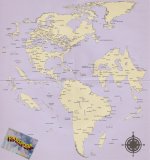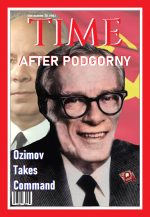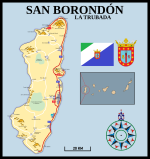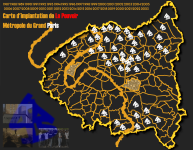-
Hi Guest!
The costs of running this forum are covered by Sea Lion Press. If you'd like to help support the company and the forum, visit patreon.com/sealionpress
You are using an out of date browser. It may not display this or other websites correctly.
You should upgrade or use an alternative browser.
You should upgrade or use an alternative browser.
Heechee's Serial Experiments
- Thread starter SerialExperimentsHeechee
- Start date
SerialExperimentsHeechee
Active member
A Study on Murcian Non-Existence
This is a rather... weird thought exercise on my home region, and I'll try to sum it up as much as I can: from a certain perspective, it makes more sense that Murcia doesn't exist, even if it does.
Of course, my region has not lived in isolation in history, but many of its episodes -Hasdrubal and the foundation of Carthago Nova -or that of Cartagena de Indias, that could well be called Puerto de Indias instead-, Alfonso X and his links to the city, the role in the Spanish War of Sucession, the Cantonalista experiment... they can all be handwaved or focused somewhere else without having to flap butterflies a lot. Murcia itself, OTOH, stands as an oddity. Partly Eastern -perfectly a non-Catalan-Speaking part of the Spanish Levante-, partly Southern, Castilian by adoption and at times conviction more than in spirit, Aragonese in some of its customs, Murcia seems to be a portmanteau made on purpose. As a sort of accomodatingly backwards and corrupt place, a caricaturesque reflection like Orbajosa. As a running joke and punching bag, an Anywhere like Springfield. Murcia needs the world, but the world certainly doesn't need Murcia, its dubious legends and strange places almost nobody knows, its grudges and its arid lack of grace.
When we think about counterfactuals, we think about worlds with added and/or changed content. I ask you to think about worlds with *substracted* content. There could be a world where Dubai, Detroit or Hong Kong are as fictional as Gotham City. Where Andorra or Montenegro are as unreal as Ruritania or Syldavia. Where Transnistria is no less of a videogame setting than Erangel Island or Tarkov. Where El Salvador is their Val Verde. But you get it now. I ask you now, and it's not an ardous task, to make the place where I hail from disappear from the premises as Spain's own Molise. Then I present you another fictional concept, a certain Murcia, should it exist where it doesn't. Maybe as the setting map of a quest or an open world, something to play with and dismiss afterwards. Let's play, then.
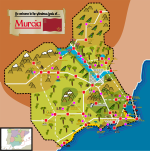
This is a rather... weird thought exercise on my home region, and I'll try to sum it up as much as I can: from a certain perspective, it makes more sense that Murcia doesn't exist, even if it does.
Of course, my region has not lived in isolation in history, but many of its episodes -Hasdrubal and the foundation of Carthago Nova -or that of Cartagena de Indias, that could well be called Puerto de Indias instead-, Alfonso X and his links to the city, the role in the Spanish War of Sucession, the Cantonalista experiment... they can all be handwaved or focused somewhere else without having to flap butterflies a lot. Murcia itself, OTOH, stands as an oddity. Partly Eastern -perfectly a non-Catalan-Speaking part of the Spanish Levante-, partly Southern, Castilian by adoption and at times conviction more than in spirit, Aragonese in some of its customs, Murcia seems to be a portmanteau made on purpose. As a sort of accomodatingly backwards and corrupt place, a caricaturesque reflection like Orbajosa. As a running joke and punching bag, an Anywhere like Springfield. Murcia needs the world, but the world certainly doesn't need Murcia, its dubious legends and strange places almost nobody knows, its grudges and its arid lack of grace.
When we think about counterfactuals, we think about worlds with added and/or changed content. I ask you to think about worlds with *substracted* content. There could be a world where Dubai, Detroit or Hong Kong are as fictional as Gotham City. Where Andorra or Montenegro are as unreal as Ruritania or Syldavia. Where Transnistria is no less of a videogame setting than Erangel Island or Tarkov. Where El Salvador is their Val Verde. But you get it now. I ask you now, and it's not an ardous task, to make the place where I hail from disappear from the premises as Spain's own Molise. Then I present you another fictional concept, a certain Murcia, should it exist where it doesn't. Maybe as the setting map of a quest or an open world, something to play with and dismiss afterwards. Let's play, then.

SerialExperimentsHeechee
Active member
SerialExperimentsHeechee
Active member
Global Crossroads
A very crude prototype board for a game I designed, or at the very least I basically outlined.
In it, each region has a "rating", indicating under a single category several stuff such as wealth and well-being -ratings can go up or down during the game and there are numerical markers for that end. In addition, there are influence markers for the countries and organizations whose flag is shown, corporate markers for corporate presence (their HQs are pre-marked on the map), representing from delivery services to petrochemistry. There are unrest and war markers, and finally, a marker indicates the state of the stock market in the sequence at the bottom of the map -the marker can only go right and repeating the cycle means directly going from boom to bust, the red areas indicating a state of global recession.
In the game, players choose a card from the goal deck and try to accomplish the goal executing actions displayed and renewed for everyone from the action deck. Action cards usually introduce or remove conflicts, increase or diminish influence of a political or economic power, have an effect on the stock markets or the well-being of given areas, often just if certain conditions are met. A goal card can set from increasing the influence of a corporation to cause a civil war inside a power; from developing a region up to certain point to increasing the influence of a power over said region; from mitigating unrest and war to causing several recessions. Players don't know their opponents' goals, and only by gameplay can deduce what the others are trying to do and try to thwart it.
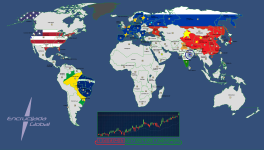
A very crude prototype board for a game I designed, or at the very least I basically outlined.
In it, each region has a "rating", indicating under a single category several stuff such as wealth and well-being -ratings can go up or down during the game and there are numerical markers for that end. In addition, there are influence markers for the countries and organizations whose flag is shown, corporate markers for corporate presence (their HQs are pre-marked on the map), representing from delivery services to petrochemistry. There are unrest and war markers, and finally, a marker indicates the state of the stock market in the sequence at the bottom of the map -the marker can only go right and repeating the cycle means directly going from boom to bust, the red areas indicating a state of global recession.
In the game, players choose a card from the goal deck and try to accomplish the goal executing actions displayed and renewed for everyone from the action deck. Action cards usually introduce or remove conflicts, increase or diminish influence of a political or economic power, have an effect on the stock markets or the well-being of given areas, often just if certain conditions are met. A goal card can set from increasing the influence of a corporation to cause a civil war inside a power; from developing a region up to certain point to increasing the influence of a power over said region; from mitigating unrest and war to causing several recessions. Players don't know their opponents' goals, and only by gameplay can deduce what the others are trying to do and try to thwart it.

SerialExperimentsHeechee
Active member
La Ribera City
The premise for this scenario doesn't lie in the city itself, but at the other side of its coast, the Mar Menor. In fact, it goes a bit beyond that: The Spanish economy was just a little bit more buoyant during the Desarrollismo for the Law of Centers and Zones of National Touristic Interest to resist a bit more with better funding, enough for the urbanization of La Manga to be much closer to the original Plan Bonet: relatively low-density and interrumpted every two kilometers by Modernist habitational units -a more cohesive La Manga that would end up having its own municipality. This didn't put a brake to real state speculation, but displaced it to the other side, to the almost contiguous municipalities of San Javier and San Pedro, which underwent the same megalomaniac urban transformation that La Manga did ITTL. During the Transition, a process of aggregation and finally fusion of municipalities slowly took place, ultimately including a Los Alcázares that got segregated from Torre Pacheco. La Ribera became the second city in the Murcia region by population, the first in seasonal time and the first in extension by far, and this altered the infrastructural dynamics of the region -the Corvera Airport was never built, to cite one-, and even the political one, as the eventual degradation of the state of the lagoon found a much more pressing lobby to counter the agroindustrial one.
The core city, shown in the map, is divided in Diputaciones de Distrito, urban Pedanías and boroughs in practice. San Javier is mostly residential and administrative, and a gateway to the city. Santiago is the postcard touristic part, where the skyline of residential scrapers and the most lively pub areas are. Lo Pagán is a slightly degraded, bottom-end residential and touristic area. San Pedro is where most of the fishermen of both seas and the farmers for the nearby agrigultural plantations live, and has a sizable population of Moroccan origin. Ciudad del Aire, apart from the main aerial facilities of the city, hosts mostly retail shops and warehouses, and it's the least populated Diputación de Distrito. Los Narejos is a sort of chic, top-end area. Finally, Los Alcázares is an eclectic hodgepodge where you can see from a numerous Sikh community to young bohemians, and which has a reputation of living turning its back on the rest of the city.
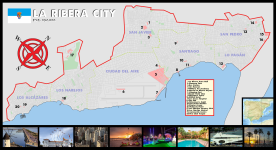
The premise for this scenario doesn't lie in the city itself, but at the other side of its coast, the Mar Menor. In fact, it goes a bit beyond that: The Spanish economy was just a little bit more buoyant during the Desarrollismo for the Law of Centers and Zones of National Touristic Interest to resist a bit more with better funding, enough for the urbanization of La Manga to be much closer to the original Plan Bonet: relatively low-density and interrumpted every two kilometers by Modernist habitational units -a more cohesive La Manga that would end up having its own municipality. This didn't put a brake to real state speculation, but displaced it to the other side, to the almost contiguous municipalities of San Javier and San Pedro, which underwent the same megalomaniac urban transformation that La Manga did ITTL. During the Transition, a process of aggregation and finally fusion of municipalities slowly took place, ultimately including a Los Alcázares that got segregated from Torre Pacheco. La Ribera became the second city in the Murcia region by population, the first in seasonal time and the first in extension by far, and this altered the infrastructural dynamics of the region -the Corvera Airport was never built, to cite one-, and even the political one, as the eventual degradation of the state of the lagoon found a much more pressing lobby to counter the agroindustrial one.
The core city, shown in the map, is divided in Diputaciones de Distrito, urban Pedanías and boroughs in practice. San Javier is mostly residential and administrative, and a gateway to the city. Santiago is the postcard touristic part, where the skyline of residential scrapers and the most lively pub areas are. Lo Pagán is a slightly degraded, bottom-end residential and touristic area. San Pedro is where most of the fishermen of both seas and the farmers for the nearby agrigultural plantations live, and has a sizable population of Moroccan origin. Ciudad del Aire, apart from the main aerial facilities of the city, hosts mostly retail shops and warehouses, and it's the least populated Diputación de Distrito. Los Narejos is a sort of chic, top-end area. Finally, Los Alcázares is an eclectic hodgepodge where you can see from a numerous Sikh community to young bohemians, and which has a reputation of living turning its back on the rest of the city.

Last edited:
SerialExperimentsHeechee
Active member
A Stick in Every Wheel
In this world, a more vigorous Persia came out from the dissolution of the Alexandrian Empire. A Persia that underwent a Buddhist transformation from the Greco-Bactrian Kingdom and that was the main outer destabilizing factor in the latter days of the Roman Empire, along with latter Mongolian and Buddhist (C)Hun invasions -this was called the West Wind Blow-, though syncretism with christianity prevailed in many areas, especially in Misrayim/Egypt, spreading to Arapia, but also present in certain parts of Ispahanistan. Fast-forward a few centuries, and all main centers of civilization are Buddhist in one way or another.
Geopolitics reflect the pushing of the cultural iranized sphere and those who resist it (including the _also_ iranized but historical adversary of the Fair Shield -the iranization excludes Norsk and the Hunnic, plurality Slavic Chunia-, and a particularly isolated and authoritarian Order of Sudovia); the different national schools of thought and their areas of influence, never missing anywhere the heated debates between Left and Right Hand streams, beween Small, Big and Intermediate vehicles; the places where a pluralistic attitude towards ways of attaining enlightenment favored a rather more politically pluralistic environment, and the heritages of colonialism and decolonization. Governments tend to the conservative and managerial, and there are much more theocracies -Nuristan is ruled by the patron Boddhisattva of the Alps-, technology is not so much less advanced (it *is* slightly less advanced) as less spread -it is a much more pastoral, rural world, that from our perspective would look both calmer and backwards even in the main trading and religious cities of the world. Said cities tend to the ornate and mathematically near-psychedelic baroque or to the spartan and minimalistic, with almost no in-between. Science for the sake of science and contemplative studies are, on the other hand, much more widespread since the emergence and diffusion of the Nai-Lokataya streams, as they are much more mixed with sapiental woo depending on the place.
But a specter is haunting the world. The Schools of Rescue have changed everything. They're life-affirming, and in the most mainstream forms -the outsider forms tend to the sadomasochistic- preach a degree of Dukkha is an acceptable inconvenience for the gift of the eternal cycle. Budhahood, if really possible, means annihilation, and its tenets mean painting a negative veneer of inaction over the world. Buddhahood must be stopped at all costs.
So far, most schools are secret societies, though some are evolved into well-funded guerrillas. The world is experiencing a transformative culture war like it has never seen. But who's the stick in the wheel there, the Enlighteners who put an end to a cycle of suffering, or the Rescuers who put an end to stagnant yet continous dynamics?
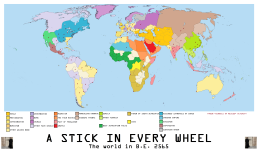
In this world, a more vigorous Persia came out from the dissolution of the Alexandrian Empire. A Persia that underwent a Buddhist transformation from the Greco-Bactrian Kingdom and that was the main outer destabilizing factor in the latter days of the Roman Empire, along with latter Mongolian and Buddhist (C)Hun invasions -this was called the West Wind Blow-, though syncretism with christianity prevailed in many areas, especially in Misrayim/Egypt, spreading to Arapia, but also present in certain parts of Ispahanistan. Fast-forward a few centuries, and all main centers of civilization are Buddhist in one way or another.
Geopolitics reflect the pushing of the cultural iranized sphere and those who resist it (including the _also_ iranized but historical adversary of the Fair Shield -the iranization excludes Norsk and the Hunnic, plurality Slavic Chunia-, and a particularly isolated and authoritarian Order of Sudovia); the different national schools of thought and their areas of influence, never missing anywhere the heated debates between Left and Right Hand streams, beween Small, Big and Intermediate vehicles; the places where a pluralistic attitude towards ways of attaining enlightenment favored a rather more politically pluralistic environment, and the heritages of colonialism and decolonization. Governments tend to the conservative and managerial, and there are much more theocracies -Nuristan is ruled by the patron Boddhisattva of the Alps-, technology is not so much less advanced (it *is* slightly less advanced) as less spread -it is a much more pastoral, rural world, that from our perspective would look both calmer and backwards even in the main trading and religious cities of the world. Said cities tend to the ornate and mathematically near-psychedelic baroque or to the spartan and minimalistic, with almost no in-between. Science for the sake of science and contemplative studies are, on the other hand, much more widespread since the emergence and diffusion of the Nai-Lokataya streams, as they are much more mixed with sapiental woo depending on the place.
But a specter is haunting the world. The Schools of Rescue have changed everything. They're life-affirming, and in the most mainstream forms -the outsider forms tend to the sadomasochistic- preach a degree of Dukkha is an acceptable inconvenience for the gift of the eternal cycle. Budhahood, if really possible, means annihilation, and its tenets mean painting a negative veneer of inaction over the world. Buddhahood must be stopped at all costs.
So far, most schools are secret societies, though some are evolved into well-funded guerrillas. The world is experiencing a transformative culture war like it has never seen. But who's the stick in the wheel there, the Enlighteners who put an end to a cycle of suffering, or the Rescuers who put an end to stagnant yet continous dynamics?

SerialExperimentsHeechee
Active member
Hullaballoo
"There were many Hullabaloos, though it was only one thing. Its center was, of course, New York City - the self-declared Olympic and post-Default capital of the free world, shining on its way back from Hell. And yet, each city worth mentioning had its own. If you were young in America, the eighties were, undoubtedly, the years of the Hullabaloo, and that often brings back images and sounds that have been revisited over and over through the years. Arcade machines and early Minitel terminals, blast beats mixing with electro samples, women of backcombed hair and nuclear white smile announcing premium marijuana strains, ambitious yappers of big sideburns and bulky electronics sharing the streets with spooky youngsters imitating Diamanda Galas and Trent Reznor, forever young by virtue of the 27 club. Beyond the cultural cliche it has become, it was essentially a contradiction: a countercultural wave unashamedly fueled by State support. Its energy was weirdly in touch with the futuristic vision of America that Kennedy represented. And, as a vision, it was under siege. Sieged by the bombs and the gunshots of the Army of Christ, sieged by the specter of Shiite retaliation and the atrocities of the decade-long Iran-Iraq War, and sieged by the reap of ACID, the feared Acquired Chronic Immunological Disorder, putting a serious strain in our very first attempt at a public health system... but we were often besieged by ourselves, always one step away to pay too much for our own mistake, of not knowing the enormity of what we were taking part of in relation to ourselves, while the unraveling Eastern Bloc looked at us in awe.
In the end? Not a bang, but a whimper. The new became stale, then classic, then old. Other generations, fashions and gadgets came, taking past victories for granted and writing their own stories as they fought their own battles. The Hullabaloo was not a revolution: it was just another moment in time. But it was undoubtedly our time."

"There were many Hullabaloos, though it was only one thing. Its center was, of course, New York City - the self-declared Olympic and post-Default capital of the free world, shining on its way back from Hell. And yet, each city worth mentioning had its own. If you were young in America, the eighties were, undoubtedly, the years of the Hullabaloo, and that often brings back images and sounds that have been revisited over and over through the years. Arcade machines and early Minitel terminals, blast beats mixing with electro samples, women of backcombed hair and nuclear white smile announcing premium marijuana strains, ambitious yappers of big sideburns and bulky electronics sharing the streets with spooky youngsters imitating Diamanda Galas and Trent Reznor, forever young by virtue of the 27 club. Beyond the cultural cliche it has become, it was essentially a contradiction: a countercultural wave unashamedly fueled by State support. Its energy was weirdly in touch with the futuristic vision of America that Kennedy represented. And, as a vision, it was under siege. Sieged by the bombs and the gunshots of the Army of Christ, sieged by the specter of Shiite retaliation and the atrocities of the decade-long Iran-Iraq War, and sieged by the reap of ACID, the feared Acquired Chronic Immunological Disorder, putting a serious strain in our very first attempt at a public health system... but we were often besieged by ourselves, always one step away to pay too much for our own mistake, of not knowing the enormity of what we were taking part of in relation to ourselves, while the unraveling Eastern Bloc looked at us in awe.
In the end? Not a bang, but a whimper. The new became stale, then classic, then old. Other generations, fashions and gadgets came, taking past victories for granted and writing their own stories as they fought their own battles. The Hullabaloo was not a revolution: it was just another moment in time. But it was undoubtedly our time."

SerialExperimentsHeechee
Active member
Tropical Heat
Loosely inspired by Black Lagoon and real life places (Indonesia, Brazil, South East Asia, among others). I apologize for the J.K. Rowling Effect in naming conventions, which surely get more ridiculous the less I know about the inspiring cultures.
This world is rather warmer and wetter, with degrees of tropical temperature being pretty much the rule except close to the poles and in isolate desert pockets. It is a poorer and more corrupt world on average, and also much more densely populated -megacities surrounded by slums are the rule here. Geopolitically, it has reached a postcolonial/neocolonial phase after centuries of Viraja's westward expansion, and no power seems to clearly dominate, though Bentacamarca and Rayana seem to be the latest emerging powers nowadays -*Portuguese here was a minority language and ethnicity inside Castreja that became dominant in some of the colonies. Technology stands around our late 90s, with some key differences -the most important being nuclear fission was never put into practice and dependence on fossil fuels is, for the time being, rather more acute. The geographical features of this rather more insular world make shipping logistics to be a far more important aspect of global trade -as it is the presence of piracy, one that extends its tendrils to an extent it even jeopardizes the very same international cooperation that's supposed to tackle it.
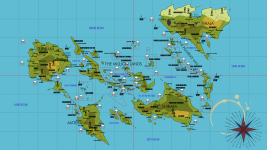
Loosely inspired by Black Lagoon and real life places (Indonesia, Brazil, South East Asia, among others). I apologize for the J.K. Rowling Effect in naming conventions, which surely get more ridiculous the less I know about the inspiring cultures.
This world is rather warmer and wetter, with degrees of tropical temperature being pretty much the rule except close to the poles and in isolate desert pockets. It is a poorer and more corrupt world on average, and also much more densely populated -megacities surrounded by slums are the rule here. Geopolitically, it has reached a postcolonial/neocolonial phase after centuries of Viraja's westward expansion, and no power seems to clearly dominate, though Bentacamarca and Rayana seem to be the latest emerging powers nowadays -*Portuguese here was a minority language and ethnicity inside Castreja that became dominant in some of the colonies. Technology stands around our late 90s, with some key differences -the most important being nuclear fission was never put into practice and dependence on fossil fuels is, for the time being, rather more acute. The geographical features of this rather more insular world make shipping logistics to be a far more important aspect of global trade -as it is the presence of piracy, one that extends its tendrils to an extent it even jeopardizes the very same international cooperation that's supposed to tackle it.

SerialExperimentsHeechee
Active member
Cobain Survives
In this scenario, Kurt Cobain's pre-rehab intervention was successfully carried out, and he ended up in another, more behavioral-focused rehab center. Eventually the professionals around him made him fully understand that his heroin habit and his depression were reinforcing each other. He left rehab on summer '94, on methadone and antidepressants, decided to focus on time with his family and musical experimentation, initially consistent mainly on covers of folk songs and artists of his liking, as well as a project along with Michael Stipe. The live album Verse Chorus Verse was released on november '94, and the next year the fourth studio album was released reaching levels of acclaim comparable to In Utero. Boddah, committed to Kurt's inner voice, included songs like You Know You're Right, Poison's Gone, Do Re Mi and the old, all-the-more-relevant rarity Opinion, as well as many songs composed in his post-rehab period. Several songs by Dave Grohl were included in parallel side projects.
The 95-96 tour was particularly exhausting at a time in which Kurt's marriage and allegedly also his self-image were falling apart (it's an open secret that Kurt may be at the very least genderqueer, but Kurt has never confirmed nor denied this, but toyed with the confusion); in addition, Dave Grohl was pursuing his own musical projects, and so the band disbanded shortly afterwards. They would none the less leave a farewell gift: Nirvana's self-titled album found much more moderate success as the public and the critics alike found it "too disjointed" -many Dave Grohl songs were included, and the contrast between his relatively upbeat style and the acoustic experiments of Kurt contributed to this feeling as much as anticipated their artistic paths. And yet, in spite of its lukewarm reception, it would end up acquiring cult status just a few years after the disbandment. Kurt dedicated most of the subsequent years collaborating with other artists and recording and producing independent and highly experimental albums. That wouldn't be the end of Nirvana, though, as by mediation of Pat Smear they reunited and produced a sixth and final studio album with motive of the 30th anniversary of the band. As the flapping butterflies meant Chris Cornell never commited suicide, in this world it is Layne Staley who is considered the main martyr of the grunge movement, as he sadly died of an overdose in the early 00s as IOTL.
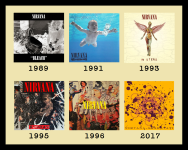
In this scenario, Kurt Cobain's pre-rehab intervention was successfully carried out, and he ended up in another, more behavioral-focused rehab center. Eventually the professionals around him made him fully understand that his heroin habit and his depression were reinforcing each other. He left rehab on summer '94, on methadone and antidepressants, decided to focus on time with his family and musical experimentation, initially consistent mainly on covers of folk songs and artists of his liking, as well as a project along with Michael Stipe. The live album Verse Chorus Verse was released on november '94, and the next year the fourth studio album was released reaching levels of acclaim comparable to In Utero. Boddah, committed to Kurt's inner voice, included songs like You Know You're Right, Poison's Gone, Do Re Mi and the old, all-the-more-relevant rarity Opinion, as well as many songs composed in his post-rehab period. Several songs by Dave Grohl were included in parallel side projects.
The 95-96 tour was particularly exhausting at a time in which Kurt's marriage and allegedly also his self-image were falling apart (it's an open secret that Kurt may be at the very least genderqueer, but Kurt has never confirmed nor denied this, but toyed with the confusion); in addition, Dave Grohl was pursuing his own musical projects, and so the band disbanded shortly afterwards. They would none the less leave a farewell gift: Nirvana's self-titled album found much more moderate success as the public and the critics alike found it "too disjointed" -many Dave Grohl songs were included, and the contrast between his relatively upbeat style and the acoustic experiments of Kurt contributed to this feeling as much as anticipated their artistic paths. And yet, in spite of its lukewarm reception, it would end up acquiring cult status just a few years after the disbandment. Kurt dedicated most of the subsequent years collaborating with other artists and recording and producing independent and highly experimental albums. That wouldn't be the end of Nirvana, though, as by mediation of Pat Smear they reunited and produced a sixth and final studio album with motive of the 30th anniversary of the band. As the flapping butterflies meant Chris Cornell never commited suicide, in this world it is Layne Staley who is considered the main martyr of the grunge movement, as he sadly died of an overdose in the early 00s as IOTL.

Last edited:
SerialExperimentsHeechee
Active member
Blackentheborg
Dennis Skinner's molotov
- Location
- Grand Hotel Abyss
- Pronouns
- He/Him
Oh yeah, that's the good shit right thereCobain Survives
In this scenario, Kurt Cobain was spotted when trying to jump the wall of the Exodus Recovery Center, and put under supervision. Eventually the professionals around him made him fully understand that his heroin habit and his depression were reinforcing each other. He left rehab on summer '94, on methadone and antidepressants, decided to focus on time with his family and musical experimentation, initially consistent mainly on covers of folk songs and artists of his liking. The live album Verse Chorus Verse was released on november '94, and the next year the fourth studio album was released reaching levels of acclaim comparable to In Utero. Boddah, committed to Kurt's inner voice, included songs like You Know You're Right, Poison's Gone, Do Re Mi and the old, all-the-more-relevant rarity Opinion, as well as many songs composed in his post-rehab period. Several songs by Dave Grohl were included in parallel side projects.
The 95-96 tour was particularly exhausting at a time in which Kurt's marriage and allegedly also his self-image were falling apart (it's an open secret that Kurt may be at the very least genderqueer, but Kurt has never confirmed nor denied this, but toyed with the confusion); in addition, Dave Grohl was pursuing his own musical projects, and so the band disbanded shortly afterwards. They would none the less leave a farewell gift: Nirvana's self-titled album found much more moderate success as the public and the critics alike found it "too disjointed" -many Dave Grohl songs were included, and the contrast between his relatively upbeat style and the acoustic experiments of Kurt contributed to this feeling as much as anticipated their artistic paths. And yet, in spite of its lukewarm reception, it would end up acquiring cult status just a few years after the disbandment. Kurt dedicated most of the subsequent years collaborating with other artists and recording and producing independent and highly experimental albums. That wouldn't be the end of Nirvana, though, as by mediation of Pat Smear they reunited and produced a sixth and final studio album with motive of the 30th anniversary of the band. As the flapping butterflies meant Chris Cornell never commited suicide, in this world it is Layne Staley who is considered the main martyr of the grunge movement, as he sadly died of an overdose in the early 00s as IOTL.
View attachment 71606
SerialExperimentsHeechee
Active member
SerialExperimentsHeechee
Active member
The Levante Conflict
Cartagena and Murcia have a contentious history. The former city feels the latter has usurped Cartagena's rightful place in the southeastern peninsula and is subjected to an unfair treatment, and looks towards a Roman past and away from the medieval myths that conform the basis of Murcian identity. In this scenario, those points of contention have created the most intractable conflict of modern times[1].
The conflict as it is right now started with the collapse of the Federal Spanish authority in the 1940s and with Cartagena's refusal to submit to the Murcian authority. A dual-state solution was devised but the attacks byproduct of grudges and irredentism and the fact Murcia was under more-or-less continuous attack by her neighbors, turned Murcian authorities paranoid and expeditious in methods. Franco-British investment and support of this strategic Iberian enclave went often towards modernization of the military, and the neighbours' war declarations towards Murcia tended to end badly.
As of 2023, Albacete is suffering the last stages of a long civil war between its authoritarian Loyalist forces and a coalition of Integrist, Concejista and Pan-Castilianist opposition, which seems to have lost the conflict. The Catalan Republic of Valencia, confederated with the other Catalan republics, needed to resort to power-sharing between its Castilian and its Valencian-Speaking population after the veguerías around Alicante saw a long conflict and the emergence of Catalan-funded sectarian militant parties such as the Partit de la Creu, Creu for short in international parlance, which hostigate Murcia over the Carxe question. Andalusia was reformed as the Kingdom of Betica under the banner of a claimant of Nazari descendance, and though it's currently a relatively prosper and stable place, it's not devoid of a history of territoral frictions with Murcia.
Cartagena can be seen either as the thorn on the side of Murcia or the victim of Murcia's segregationist and neocolonial practices, with its capital and most populous city further alienated from its natural territory by thick walls and checkpoints, an open-air prison in practice. While the territory of Cismarítima is controled by the Cantonal Party of Cartagena, which carries the banner of the historic struggle against Murcian occupation, the rather more militant Azogue rules the Cartagena stripe. Recently, Cartagena militants from Azogue broke the last truce by breaching the walls and exerting a bloody attack with rockets and militants towards centers of population and civilian gatherings, followed by Creu opportunistic attacks. The Murcian response will be swift and brutal.
[1]The analogies are not 1:1, but they'll have to suffice.

Cartagena and Murcia have a contentious history. The former city feels the latter has usurped Cartagena's rightful place in the southeastern peninsula and is subjected to an unfair treatment, and looks towards a Roman past and away from the medieval myths that conform the basis of Murcian identity. In this scenario, those points of contention have created the most intractable conflict of modern times[1].
The conflict as it is right now started with the collapse of the Federal Spanish authority in the 1940s and with Cartagena's refusal to submit to the Murcian authority. A dual-state solution was devised but the attacks byproduct of grudges and irredentism and the fact Murcia was under more-or-less continuous attack by her neighbors, turned Murcian authorities paranoid and expeditious in methods. Franco-British investment and support of this strategic Iberian enclave went often towards modernization of the military, and the neighbours' war declarations towards Murcia tended to end badly.
As of 2023, Albacete is suffering the last stages of a long civil war between its authoritarian Loyalist forces and a coalition of Integrist, Concejista and Pan-Castilianist opposition, which seems to have lost the conflict. The Catalan Republic of Valencia, confederated with the other Catalan republics, needed to resort to power-sharing between its Castilian and its Valencian-Speaking population after the veguerías around Alicante saw a long conflict and the emergence of Catalan-funded sectarian militant parties such as the Partit de la Creu, Creu for short in international parlance, which hostigate Murcia over the Carxe question. Andalusia was reformed as the Kingdom of Betica under the banner of a claimant of Nazari descendance, and though it's currently a relatively prosper and stable place, it's not devoid of a history of territoral frictions with Murcia.
Cartagena can be seen either as the thorn on the side of Murcia or the victim of Murcia's segregationist and neocolonial practices, with its capital and most populous city further alienated from its natural territory by thick walls and checkpoints, an open-air prison in practice. While the territory of Cismarítima is controled by the Cantonal Party of Cartagena, which carries the banner of the historic struggle against Murcian occupation, the rather more militant Azogue rules the Cartagena stripe. Recently, Cartagena militants from Azogue broke the last truce by breaching the walls and exerting a bloody attack with rockets and militants towards centers of population and civilian gatherings, followed by Creu opportunistic attacks. The Murcian response will be swift and brutal.
[1]The analogies are not 1:1, but they'll have to suffice.

SerialExperimentsHeechee
Active member
Doomed to Understanding: The Unión Dinástica
A flag representing a hypothetical future dynastic union between Spain and Morocco. Princess Leonor of Spain marries Prince Moulay Hassan of Morocco, their son holding the title both of King of Spain and of King of Morocco somewhere in the 22nd century, and creating what could be seen as a rather perplexing situation that is, none the less, the peaceful resolution of a tense history of interdependent frenemity.
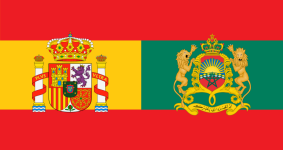
A flag representing a hypothetical future dynastic union between Spain and Morocco. Princess Leonor of Spain marries Prince Moulay Hassan of Morocco, their son holding the title both of King of Spain and of King of Morocco somewhere in the 22nd century, and creating what could be seen as a rather perplexing situation that is, none the less, the peaceful resolution of a tense history of interdependent frenemity.

SerialExperimentsHeechee
Active member
Vaserra
A fantasy setting I've been brewing in my head since my pre-teen years, in a mythical past. Not extremely groundbreaking, in fact using many equivalences and cliches, but hey.
Vaserra exists in a flat, disc-shaped earth which roughly divides the cosmos in two hemispheres; perpendicular to it, the sun revolves around it in an oscillating manner which causes the seasons: winter days are long and summer days are short. The firmament is indeed a vault. The rim of the disc is formed by chasms of ice, and as a rule of thumb, the closer to the center of the disk, the hotter the climate, by induction of an incandescent subterranean core. Vaserra stands fairly close to the center of the terrestrial circumference, to its north and east. This world is mostly inhabited by baseline humans, the most succesful subspecies of humanity, but other subspecies (mainly elves, dwarves and orcs, but also the more secretive and elusive goblins, gnomes and fair folk) live either integrated in human society or, especially in the case of the much-stigmatized orcs, at its margins. You can mostly find dwarven communities in the rugged terrain of Vaserra, the more the further north you go, and some marauding orcish communities, the more the further south you go. In addition to all of this, many animals display obvious signs of sapience. The most technologically advanded nations exist roughly at that point where the Upper Middle Ages ended and the Early Modern Era began. Magic exists, or rather, magically charged artifacts exist and are actually a perfectly normal part of the natural world. That crystal ball that makes you see the future is just emanating a resonance in phase with your pineal gland, making you derive effects from causality so efficiently that it creates an illusion of clairvoyance. That Al-Ragashi flying carpet is woven with a kind of polar filament in a pattern that forces an equal charge distribution of quintessence, nullifying the natural motion of the carpet and putting it at will of the quintessential currents. You get the idea.
The capricious oceanic currents of this world have prevented the expansion of colonialism, and so Vaserra knows little about the Edge peoples and the peoples of the Temperate Western Rim, and only some of her merchant sailors know well about the Southern Empires (though some are starting to write about them). If you sail immediately south, you'll find the Emirate of Al-Ragash -land of minarets, scented tea and assassin clans, flanking the desert at the torrid center of the earth, that once held a foothold in Vaserra. Immediately east you'll find the intrigue-laden and excessive Querobese City-States, at times a glamourized mirror of Vaserra herself. And immediately north you'll find the political and proto-industrial powerhouse of Embervalia, seen from Vaserra with envy-fueled enemity. This includes the territorial marches of Embervalia, which start where the Deserter Mountains end (the mountains themselves a no man's land of fugitive renegades and hostile dwarven clans): Campanha may be almost the archetypical land of chivarly and exquisitely crafted castles and burgs, now existing as a margin of the Embervalian apparatus of civilization. Curious indeed that, in order to reach it by foot from Vaserra, you must meet a depauperated and antagonistic people of refugees of uncertain seafaring origin, dwelling the precarious huts of the Piety Cove. The Lupanar March is a particularly dense forestry area that seems plunged in a battle for ownership between the Embervalian Rangers and a breed of sapient wolves. The safest place to cross between Vaserra and Embervalia, in spite of it all, is the Penitent's Pass, a long cliff path between the sea and the forest, and an informal place of exchange between strangers.
Further north, the Fae-inspired and melancholically romantic Frost Throne of Hjärtavit. Further east, the imperial rule of the Kolonousía. East of Embervalia, the Prester Khans and their steppe hordes. That marks the limits of the Old World most Vaserrans know.
Vaserra itself is a confluence of kingdoms (the number has grown from the four original signataries) operating under a decentralized polysinodial system: many Councils, including the feared Oficio, are shared between kingdoms, which are each administered by its own Council. Terruñés operates as the main lingua franca between the cultivated people, though Porcelanés, Sardunyol, Beleriako, Nebreiro and Viselano are spoken too in their respective lands. The atmosphere is one of resignated hedonism, hypocritical codes of honor and stagnation, the power of the nobility and the clergy being what ties the lands together and the main thing that ostensibly works. And yet, it can be as good of a place for the beginning of an adventure as anywhere else in the world.

A fantasy setting I've been brewing in my head since my pre-teen years, in a mythical past. Not extremely groundbreaking, in fact using many equivalences and cliches, but hey.
Vaserra exists in a flat, disc-shaped earth which roughly divides the cosmos in two hemispheres; perpendicular to it, the sun revolves around it in an oscillating manner which causes the seasons: winter days are long and summer days are short. The firmament is indeed a vault. The rim of the disc is formed by chasms of ice, and as a rule of thumb, the closer to the center of the disk, the hotter the climate, by induction of an incandescent subterranean core. Vaserra stands fairly close to the center of the terrestrial circumference, to its north and east. This world is mostly inhabited by baseline humans, the most succesful subspecies of humanity, but other subspecies (mainly elves, dwarves and orcs, but also the more secretive and elusive goblins, gnomes and fair folk) live either integrated in human society or, especially in the case of the much-stigmatized orcs, at its margins. You can mostly find dwarven communities in the rugged terrain of Vaserra, the more the further north you go, and some marauding orcish communities, the more the further south you go. In addition to all of this, many animals display obvious signs of sapience. The most technologically advanded nations exist roughly at that point where the Upper Middle Ages ended and the Early Modern Era began. Magic exists, or rather, magically charged artifacts exist and are actually a perfectly normal part of the natural world. That crystal ball that makes you see the future is just emanating a resonance in phase with your pineal gland, making you derive effects from causality so efficiently that it creates an illusion of clairvoyance. That Al-Ragashi flying carpet is woven with a kind of polar filament in a pattern that forces an equal charge distribution of quintessence, nullifying the natural motion of the carpet and putting it at will of the quintessential currents. You get the idea.
The capricious oceanic currents of this world have prevented the expansion of colonialism, and so Vaserra knows little about the Edge peoples and the peoples of the Temperate Western Rim, and only some of her merchant sailors know well about the Southern Empires (though some are starting to write about them). If you sail immediately south, you'll find the Emirate of Al-Ragash -land of minarets, scented tea and assassin clans, flanking the desert at the torrid center of the earth, that once held a foothold in Vaserra. Immediately east you'll find the intrigue-laden and excessive Querobese City-States, at times a glamourized mirror of Vaserra herself. And immediately north you'll find the political and proto-industrial powerhouse of Embervalia, seen from Vaserra with envy-fueled enemity. This includes the territorial marches of Embervalia, which start where the Deserter Mountains end (the mountains themselves a no man's land of fugitive renegades and hostile dwarven clans): Campanha may be almost the archetypical land of chivarly and exquisitely crafted castles and burgs, now existing as a margin of the Embervalian apparatus of civilization. Curious indeed that, in order to reach it by foot from Vaserra, you must meet a depauperated and antagonistic people of refugees of uncertain seafaring origin, dwelling the precarious huts of the Piety Cove. The Lupanar March is a particularly dense forestry area that seems plunged in a battle for ownership between the Embervalian Rangers and a breed of sapient wolves. The safest place to cross between Vaserra and Embervalia, in spite of it all, is the Penitent's Pass, a long cliff path between the sea and the forest, and an informal place of exchange between strangers.
Further north, the Fae-inspired and melancholically romantic Frost Throne of Hjärtavit. Further east, the imperial rule of the Kolonousía. East of Embervalia, the Prester Khans and their steppe hordes. That marks the limits of the Old World most Vaserrans know.
Vaserra itself is a confluence of kingdoms (the number has grown from the four original signataries) operating under a decentralized polysinodial system: many Councils, including the feared Oficio, are shared between kingdoms, which are each administered by its own Council. Terruñés operates as the main lingua franca between the cultivated people, though Porcelanés, Sardunyol, Beleriako, Nebreiro and Viselano are spoken too in their respective lands. The atmosphere is one of resignated hedonism, hypocritical codes of honor and stagnation, the power of the nobility and the clergy being what ties the lands together and the main thing that ostensibly works. And yet, it can be as good of a place for the beginning of an adventure as anywhere else in the world.

Last edited:


